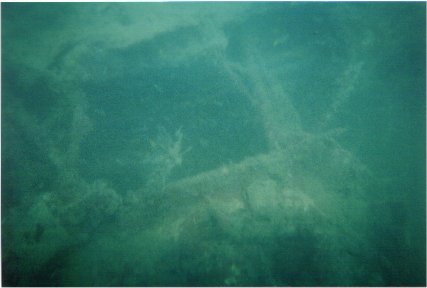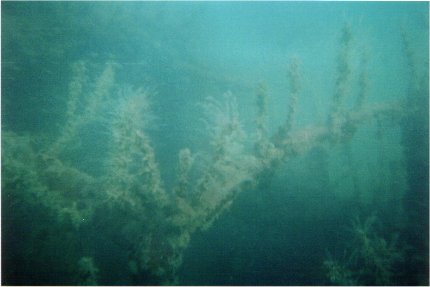CRASH OF A B-25 MITCHELL BOMBER
IN THE AREA BETWEEN ROCKY POINT SCHOOL
AND SNAPPER ISLAND, QLD
ON 8 SEPTEMBER 1944
![]()
Late on the afternoon of 8 September 1944, during the rainy season, a USAAF B-25 Mitchell #426, flew down low out of the rain squalls above the Rocky Point State School. It circled the school a number of times and then headed off southwards along the beach. It then returned and dropped three red flares. It then headed off towards Snapper Island and then turned around to head back towards the school. The students heard the engines of the B-25 stop when it ran out of fuel. There was a loud noise and some flashes of light could be seen through the rain squalls. These flashes were probably due to the aircraft's navigational lights short circuiting in the crash.
Private T. Howell of the Port Douglas Company of the Volunteer Defence Corps who was on duty at the time also reported to his Control Room at 1839 hours that an aircraft was spotted coming from the west and heading south. It passed over his Post very low. then turned east flying towards Low Isles which are about 9 miles eats of his post. Private Howell reported that the aircraft then turned west and came over Port Douglas where distress flares were seen to drop from the aircraft. Private Howell contacted his Control Room to update them, then saw the aircraft turn northwards still flying very low with its landing lights turned on. At 1906 hours Howell reported that the aircraft had crash landed on the water about one and a half miles from Rocky Point which is about 9 miles north of his post. Private Howell contacted his Control Room again and informed them of the crash landing and advised that they seemed to be OK as he could still see a light every now and then.
Private Howell was asked to stand by and do what he could for the crew of the aircraft. Howell immediately sent all of his men to patrol the beach while he borrowed a signal lamp from the Harbour Master and went down to the jetty and signalled "Are you in need of help". After a while he saw a flare on Rocky Point and someone trying to answer his signal but his light was too dim. When he contacted his Control Room again he was told that a party of men had been sent from Mossman to Rocky Point Beach and that a Navy vessel was on its way to Rocky Point.
At 0130 hours on 9 September 1944, Powell's Control Room advised that the Mossman party had picked up 5 men on Rocky Point Beach where he had seen the flares. He was told that the 5 men had been taken to a hospital at Mossman but were not badly injured. Private Howell then recalled his men from their patrol.
One of them, a Captain Miller, advised that their aircraft had left Hollandia on the northern side of New Guinea headed for Cairns. Captain Miller entertained the school children and the locals by firing off his remaining flares. He presented their rubber dinghy to the school children in appreciation for the help and concern. The dinghy contained fish hooks, fishing lines, a compass, some preserved bait and a booklet titled "Survival at Sea".
In parallel with the above activity, Harold Ives at Saltwater Bridge was also notified of the crash. He contacted the local Air Observer Corp and advised them that an aircraft had crash landed somewhere between the Rocky Point School and Snapper Island. Another local, Peggy Powell rode her bicycle to Harold Ives' house and advised him that an aircraft had crashed somewhere between her house and Low Isles. Powell's house was located about one mile north of the Rocky Point School. Using the two sources of information, the Air Observer Corps were able to roughly determine the location of the crash. About 20 minutes after the crash they sighted the same green flare spotted by Private Howell on the beach about a quarter of a mile north of the school.
|
Townsville Daily Bulletin, Wednesday 20 September 1944 FIVE AIRMEN SAVED
AFTER Due to bad local weather conditions, and the pilot uncertain of his exact position, a B-25 plane was recently forced to make a crash-landing on the sea off Mossman. Efficient organisation by V.A.O.C. Observers under Mr. A. Morgan, Chief Observer at Mossman enabled a speedy and successful rescue of all members of the crew. The duty pilot at Cairns requested information of a B-25 approaching from the North and due at Cairns, as the pilot was requesting a bearing of his true position. Sightings from Mossman and Port Douglas were given. The duty pilot informed control that the plane would drop flares to determine his position, Port Douglas reported flares dropped, and the plane heading to the north-east. The duty pilot advised control that he had lost R/T contact with the plane and sought any further information. Both Port Douglas and Mossman advised the Control that the plane appeared to land on either Rocky Point Beach or Daintree Beach, after dropping a flare and turning on its landing lights. Morgan also advised that when the plane had dropped the red flares, he had presumed that the plane was in distress, and he despatched a party to prepare a landing strip on the beach by lighting fares, this being cancelled upon advice being received that the plane had crash-landed off Rocky Point Beach. He then arranged that a launch in charge of Mr. R. Scott, with Ambulance personnel on board, proceed immediately to the scene of the crash. Port Douglas reported
that ' faint signals were still visible, suggesting Mossman advised that
the launch had returned with five officers of the U.S. Air Corps who
formed the sole complement of the crew, and that they were only
suffering from slight burns and the inconvenience of having lost
their personal gear. Arrangements were also on hand by the Chief Ob- Mr. Scott informed Control that his services would be available should it be further required for the salvage of the 'plane.
|
|
Townsville Daily Bulletin, Wednesday 20 September 1944 MELBOURNE, September 19.- Faint lights signalled from a dinghy drifting out to sea late at night off the coast of North Queensland, were noticed by members of the Voluntary Air Observers' Corps and resulted In the successful rescue of five U.S. airmen, whose plane had crashed into the sea off Mossman. The plane, which was flying from Hollandia to Cairns, became lost about nightfall, owing to bad weather conditions. The pilot requested a bearing of his true position from the duty pilot at Cairns, where he was due to land at 7.15 p.m. The duty pilot contacted the V.A.O.C. for sightings of the 'plane, from which the pilot arranged to drop flares to show observers his position. The Port Douglas observation post reported that flares were dropped from a machine turning north-east, at which stage Cairns lost further contact with it and asked the V.A.O.C. for further information. Twenty minutes later, observers, at both Port Douglas and Mossman, reported that the aircraft appeared to have landed on the beach. The chief observer at Mossman (A. Morgan) dispatched a landing party to the beach immediately. It was discovered, however, that the 'plane had crash-landed instead in the sea off Rocky Point beach, so Morgan arranged for a launch, with ambulance personnel on board in charge of R. Scott, to go to the rescue. The Port Douglas observation post reported faint signals were still visible from the sea, although they were gradually becoming less distinct. The R.A.AF. on receipt of this advice, arranged for the dispatch to the scene of a fast navy rescue launch, fitted with searchlights to comb the area for the drifting dinghy. At Mossman, the post reported the launch had returned, having picked up the entire crew of five Americans uninjured, except for slight burns. They had been drifting out to sea in the darkness, as presumed by the alert observers. |

Photo taken of the B-25 Wreckage by Michael Hughes in about January 2002

Photo taken of the B-25 Wreckage by Michael Hughes in about January 2002
ACKNOWLEDGEMENTS
I'd like to thank Mark Clayton, Michael Hughes and Denis McCarthy for their assistance with this home page.
REFERENCE BOOKS
"Schools at War - Memories of schooldays during World
War II"
By Greg Logan and Rosemary Mammino"
Townsville Daily Bulletin 14 November 1945 - Demobilisation of Northern V.D.C.
Operations Record Book for 25 Operational Base Unit RAAF
Can anyone help me with more information on this crash?
"Australia @ War" WWII Research Products
|
© Peter Dunn 2015 |
Please
e-mail me |
This page first produced 10 June 2001
This page last updated 05 January 2024